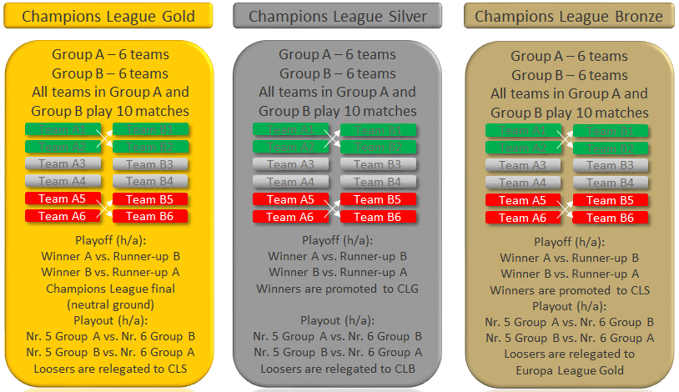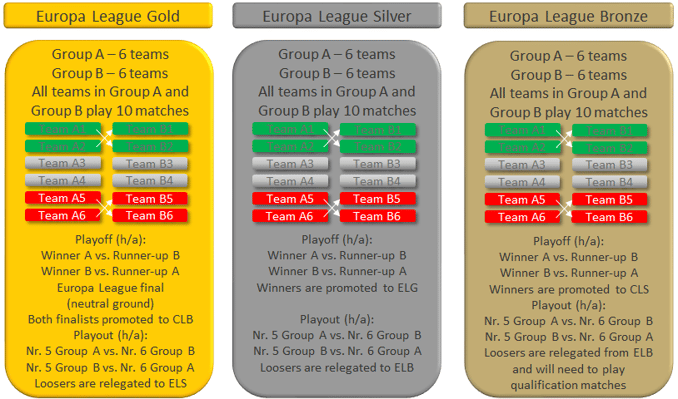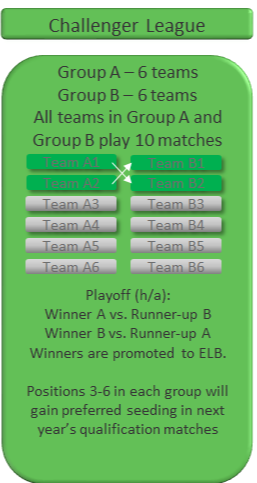The current Champions League tournament structure has been under pressure for a number of years. Several of the biggest clubs in Europe threaten to brake away from UEFA and their domestic competetions in favour of a Pan-European «Super League» with appr. 20 of the biggest clubs competing for the European Title.
This «Super League» will ensure the best players and best teams meet each other every week. These clubs look for increased income from TV-rights, advertisers and sponsors, and UEFA has been struggling to come up with an improved tournament that will meet the demands of the biggest clubs.
SportXpert presents a model for a brand new tournament structure, both for Champions League and Europa League, that will meet the demands from the biggest clubs and secure a future for both tournaments inside the UEFA.
The Champions League And Europa League new tournament structure
- 36 teams compete in each league
- Champions League and Europa League are divided into three divisions:
- Gold division with 12 teams divided into two groups; A and B
- Silver division with 12 teams divided into two groups; A and B
- Bronze division with 12 teams divided into two groups; A and B
- All teams plays 10 matches
- Top two reaches playoff finals for League winners (Gold) and promotion (Silver and Bronze)
- Bottom two faces playout for avoiding relegation to lower level
- All teams qualify based on positions in each division the previous year. Qualification follows countries, and position in national tournaments determines which teams will qualify to each division from each country.
- The division into groups follows the team ranking for all qualified teams in each division:
-
- Rank 1,4,5,8,9 and 12 in group A
- Rank 2,3,6,7,10 and 11 in group B
The New Champions League
The New Europa League
The new Challenger League format
- 12 teams qualify for the Challenger League tournament each year.
- All teams outside of the Champions League and Europa League from all UEFA countries eligible for the UEFA competitions, will enter into four qualifying rounds before reaching the Challenger League group stages.
- Additionally, there will be a preliminary round for reaching the set number of teams entering the 1st qualifying round.
- 1st round - 48 teams from the preliminary round + 96 teams directly qualifyed*
- 2nd round – 72 teams from 1st round + 4 teams preferred seeding
- 3rd round – 38 teams from 2nd round + 4 teams preferred seeding
- 4th round – 22 teams from 3rd round + 2 teams preferred seeding
- Challenger League is divided into two groups A and B with all teams playing 10 matches
- Top two in each group reaches playoff finals for promotion to Europa League Bronze. Loosing finalists will secure preferred seeding from 4th qualifying round in next year’s qualification.
- Remaining teams in positions 2-4 will secure preferred seeding from 3rd qualifying round in next year’s qualification.
- Remaining teams in positions 5-6 will secure preferred seeding from 2nd qualifying round in next year’s qualification.

Effects of the new structure
By setting up 3 levels in each tournament, we get more even matches, and all clubs will compete with other teams at a similar, relevant level. This tournament structure, dividing each division into two groups of 6 teams at each level, with the top two teams in each group qualifying for promotion and the bottom two teams fighting to avoid relegation. This will guarantee a more competitive and exiting tournament all the way until the final matches in the group stages.
By increasing the number of group matches to 10, each team will stay in the competiton much longer, and the total number of matches in the Champions League will increase from the current 125 to 205. In Europa League the total number of matches will remain at 205 even if the number of teams have been reduced from 48 to 36.
In addition, the Challenger League will open a new gateway for all countries to qualify for next year’s group stages with one extra team, and this group stage adds another 62 exciting matches to the total.
To sum up, this new tournament structure will significantly increase the total earnings for each club competing in the tournament and equally for European football as a whole.
Important: The performance of each countries’ team will determine their position in next year’s tournament. Still, each team needs to qualify for this position with their performance in the national tournaments. The only exception being the Champions League winner which always have a reserved place in the Champions League Gold, as the top seeded team.

